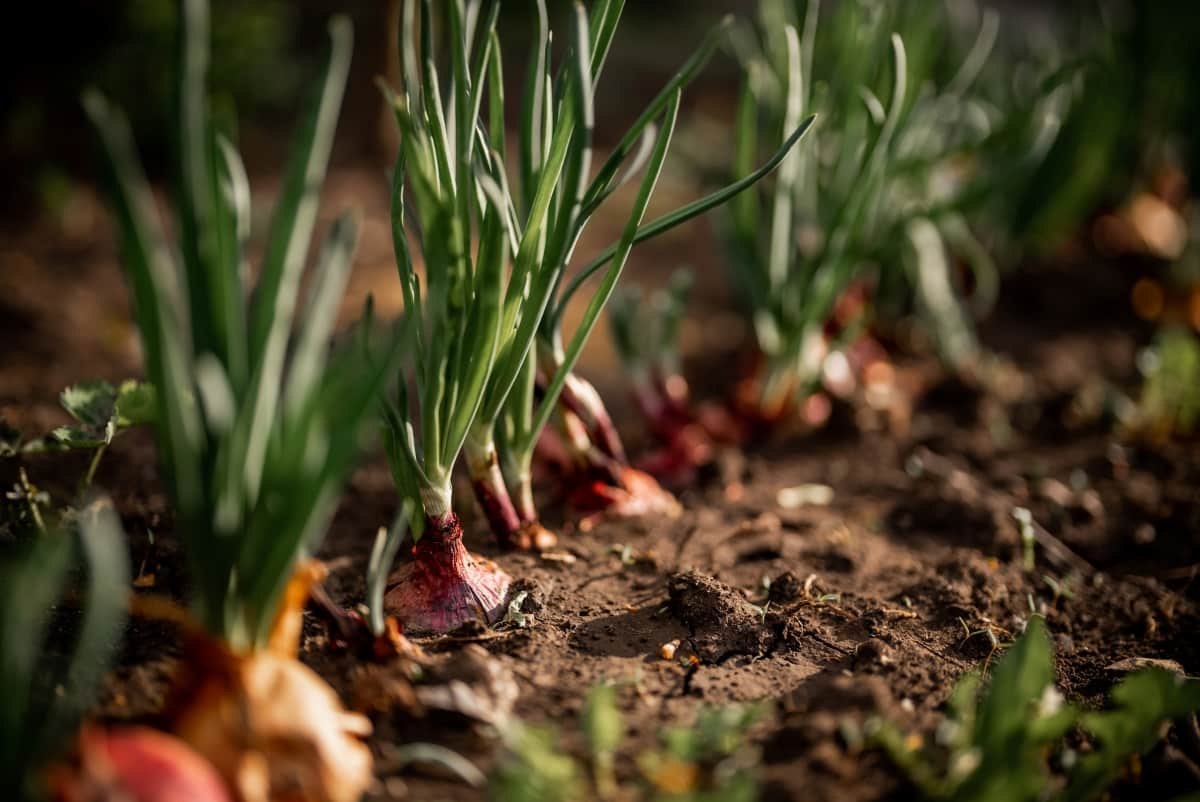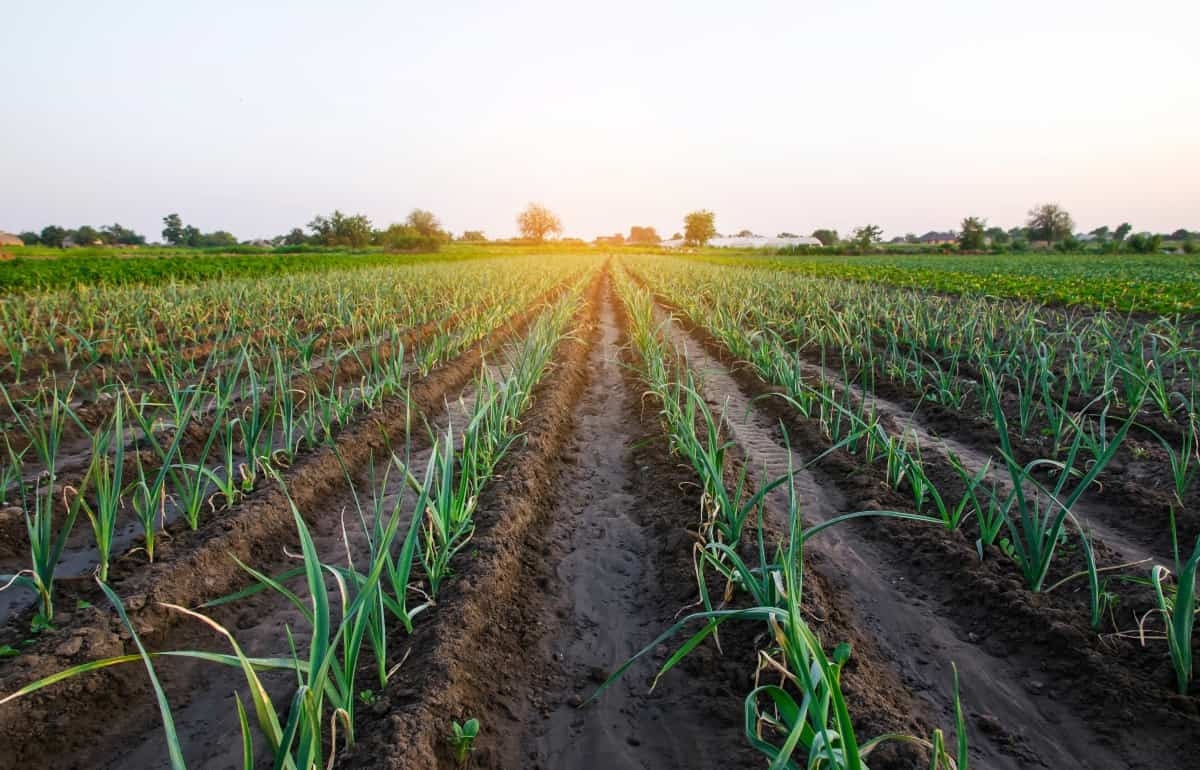Onion is the most widely cultivated crop in the world, known for its pungent flavor and various culinary uses. It belongs to the Allium family, including garlic, leeks, and chives. Common onion pests and diseases can significantly impact growth, yield, and quality.

Common Onion Pests and Diseases
Most Common Onion Pests and Diseases
- Onion pests such as thrips, maggots, bulb mites, and nematodes fed on the plant’s leaves or roots, causing stunted growth and reduced yield. These pests may also transmit viral diseases to the plants, weakening them.
- Onion diseases such as white rot disease, smut disease, purple blotch disease, and downy mildew cause discoloration of leaves or bulbs, resulting in crop loss.
Effective Control Measures for Onion Thrips Infestation
- Onion thrips are tiny insects that can wreak havoc on your onion crops. They cause wilted foliage, stunted growth, and reduced yields.
- One of the first steps in controlling onion thrips is identifying them early. You can do this by monitoring your plants regularly for signs of damage, such as silvering or stippling on the leaves. Once identified, treatment options include insecticides that contain spinosad or pyrethrin.
- Another effective way to control onion thrips is through cultural practices such as crop rotation and mulching. By rotating your crops yearly and planting onions in different areas of your garden each season, you can reduce pest populations over time.
Preventing and Treating Onion White Rot Disease
- Onion white rot disease is a fungal infection that can cause significant damage to onion crops. The fungus Sclerotium cepivorum causes it. The fungus attacks the roots of onions, causing them to rot and die off.
- One of the best ways to prevent onion white rot disease is through crop rotation. Avoid planting onions or other related plants in the same place for 3 years after an outbreak.
- Another prevention method involves the careful selection of seeds or transplants. Choose only healthy-looking seedlings or bulbs from reputable sources, and avoid those with any signs of damage or decay.
- Fungicides can also control onion white rot disease but are most effective when applied preventatively before infections occur.
- Preventing and treating onion white rot disease requires vigilance and proactive measures such as crop rotation, careful seed selection, quick removal of infected plants, and use of fungicides when necessary.
Managing Onion Maggot Damage in the Garden
- Onion maggots are one of the most common pests affecting onions in the garden. These small white larvae feed on onion roots and can cause stunted growth and plant death if left untreated.
- One effective way to manage onion maggot damage is by practicing good sanitation habits in your garden. Remove any infected plants immediately and dispose of them away from your growing area to prevent further spread of the pests.
- Another method is through physical barriers such as floating row covers or mesh netting around your onion plants.
- Use organic insecticides like neem oil or spinosad, effective against onion maggots without harming beneficial insects like bees and butterflies.
Natural Remedies for Controlling Onion Leaf Blight
- Onion leaf blight is a fungal disease that can cause serious damage to the plant leaves and bulbs of onion plants. The fungus responsible for this disease thrives in warm, moist conditions, making it difficult to control once an infection occurs.
- One effective approach is crop rotation, which involves planting onions in a different location each year to disrupt the lifecycle of the fungus.
- Another method is to compost tea as a foliar spray on your onion plants.
- Garlic extract has also been shown to have antifungal properties when used as a soil drench around the base of onion plants. Similarly, neem oil can be used as a preventative measure and treatment for fungal infections like leaf blight.
- Maintaining good garden hygiene by promptly removing infected plant debris and ensuring adequate air circulation between plants will prevent the further spread of this disease.
In case you missed it: Fungal Diseases in Onion Plants: Treatment, Control Management, and Prevention

Identifying and Managing Onion Smut Disease
- Onion smut disease is a fungal infection affecting onions and other plants. This disease can cause severe damage to crops, resulting in reduced yields and lower-quality produce.
- The most common symptom of onion smut is the appearance of black, powdery spores on the leaves and bulbs of infected plants.
- Taking preventative measures before planting your crop is important to manage onion smut disease. Make sure you use certified virus-free seedlings or sets from reputable sources. Proper soil preparation and drainage can also help prevent this disease.
Preventing and Controlling Onion Downy Mildew
- Onion downy mildew is a common disease that affects onion plants. It can cause damage to the Onion plant and lead to reduced yields.
- One of the best ways to prevent onion downy mildew is by planting resistant varieties. Some onion varieties are naturally resistant or tolerant to the disease, and using them can help reduce the risk of infection significantly.
- Another effective way of preventing and controlling onion downy mildew is by practicing good cultural practices such as crop rotation, proper sanitation, and timely weeding. These practices help create an unfavorable environment for the pathogen’s growth and spread.
Integrated Pest Management Strategies for Onion Fly Control
- One effective way to manage onion fly populations is by using crop rotation. Additionally, removing debris or plant matter from previous years’ crops can help prevent egg-laying sites for adult flies.
- Another strategy involves using physical barriers such as row covers or mesh netting to protect your growing onions from adult flies. This method traps the flying adults before they can lay eggs on your plants’ roots. However, ensuring your barrier is secure around all edges is essential because even one missed spot could result in an infestation.
- Chemical treatments are another option but should be used sparingly due to their potential harm towards non-targeted organisms like beneficial insects and soil microbes, which play important roles in maintaining soil health.
Best Practices for Managing Onion Bulb Mites
Onion bulb mites are tiny pests that can damage onions by feeding on their roots and bulbs. Maintaining proper irrigation and drainage is crucial. Proper drainage helps prevent excess moisture buildup, which attracts pests like onion bulb mites. Using organic insecticides like neem oil or insecticidal soap is an effective control measure against onion bulb mites and is safe for humans and pets. Practicing good sanitation habits, such as regularly removing weeds around your garden area, will keep your garden free from debris, which could serve as a breeding ground for these pesky insects.
Controlling Onion Root-Knot Nematodes in the Soil
- These pests burrow into the roots of the plant and cause them to become swollen and distorted, leading to stunted growth or even death.
- One way to control onion root-knot nematodes is by practicing crop rotation.
- Another effective method is solarization, which covers the soil with clear plastic during the hot summer. The heat from the sun will kill off any nematodes present in the soil.
- In addition, using soil amendments such as compost or organic matter can help improve soil health and make it more resistant to nematode infestation.
Organic Solutions for Managing Onion Purple Blotch Disease
- The symptoms of this disease include small, dark spots on leaves that increase in size and turn into a purple color with a yellowish halo.
- Cultural practices like crop rotation and proper sanitation should be adopted to manage onion purple blotch disease organically. Proper sanitation involves removing infected plant debris from the field to reduce potential sources of infection.
- Using organic fungicides can also help manage onion purple blotch disease. One effective option is using neem oil, which has antifungal properties that can suppress fungal growth. Other options include copper-based fungicides or biological control agents like Bacillus subtilis.
- Proper irrigation and fertilization practices are important to ensure good growing conditions for your onions. Healthy Onion plants are less susceptible to diseases and pests than stressed ones.
In case you missed it: Excellent Uses of Onion Peels and Kitchen Scraps for Your Garden Plants

Conclusion
Onion crops are susceptible to various pests and diseases that can significantly affect yield and quality. By understanding the symptoms, treatments, and control measures for these issues, onion growers can take proactive measures to keep their plants healthy and productive.
- Feed Your Flock for Less: Top 10 Tips to Save on Chicken Feed
- Ultimate Guide to Ossabaw Island Hog: Breeding, Raising, Diet, and Care
- Hatching Answers: The Top 10 Reasons Your Chickens Aren’t Laying Eggs
- Eggs and Economics: Breaking Down the Cost of Raising Backyard Chickens
- Defend Your Greens: Proven Methods to Keep Iguanas Out of Your Garden
- Ultimate Guide to Cinnamon Queen Chicken: A Comprehensive Guide for Beginners
- Ultimate Guide to California Tan Chicken: Breeding, Raising, Diet, Egg-Production and Care
- Ultimate Guide to Marsh Daisy Chicken: Breeding, Raising, Diet, and Care
- 10 Types of Chicken Farming Businesses You Can Start for Profits